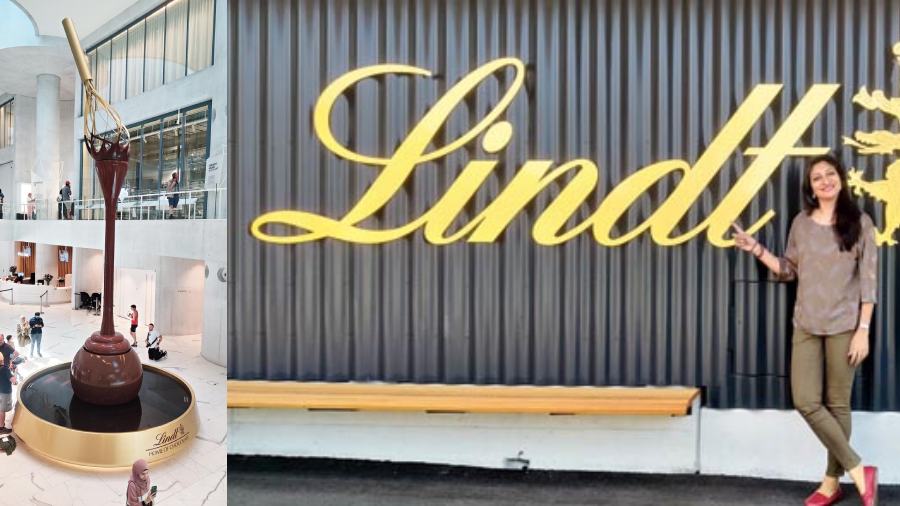One of the first things most Indians fondly associate with Switzerland are the many Yash Chopra block-busters shot in its beautiful Alpine surroundings. But we also reserve a close second and an equally sweet spot for the world-famous, melt-in your-mouth Swiss chocolates that are both a must-have and a must-bring back.
So, with two days in Zurich and a child of four in our large family group, a visit to the Lindt Home of Chocolate in the lovely Kilchberg area, overlooking the Zurich Lake, is a confirmed part of our itinerary. The museum sits at the end of a picturesque tree-lined cul de sac and welcomes us with its unmistakable logo, in embossed, matte gold.
Tickets purchased, we step into the all-white, high-ceiling edifice that has spiral staircases running at one end and an imposing 9metre-tall, live chocolate fountain occupying the centre of the ground floor lobby. A popular spot for selfies and family pictures, one has to patiently wait for one’s turn to get an undisturbed shot. With 1,500litres of fine chocolate flowing down at 150kg per second, Lindt has earned the right to boast of it as the most impressive chocolate fountain in the world. There’s chocolate in the air and how!
Taking the spiral staircase, we embark upon the Chocolate Tour that comes with a detailed, step by step audio guide. The tour is brilliantly curated and highly interactive with every narrated step of chocolate making and its history simultaneously playing out either on screen or via models.
The tour starts at the very root of the chocolate journey with cocoa beans and models of cocoa trees, pods and farmers of Ghana at work. Interesting trivia gets thrown up, such as how cocoa beans that are the main ingredient of chocolate, were once used as currency to pay for things. The tour also serves nuggets of chocolate history, tracing how the Spanish explorers brought the exotic drink back to the royal courts of Europe.
But how is it that a tiny, mountainous land such as Switzerland that was nestled in the heart of Europe, really became the final word and the chocolate capital of the world? This is where the brilliance of Lindt and other Swiss pioneers who revolutionised the world of chocolate in the 19th century stands explained.
Rodolphe Lindt or Rudolf Lindt, as he is more popularly known, was born to a pharmacist and completed his apprenticeship with a chocolate company called Amedee Kohler before he went on to set up his own unit in Berne. The chocolate that initially arrived in Europe was very different from chocolate as we know it today — it was coarse, dry and brittle. It was Lindt’s 1879 invention of ‘conching’ that changed that forever, making chocolate silky and giving it a velvety texture. The tour proudly showcases the conching machine and the story behind it. Legend has it that tired of unsuccessfully trying to produce finer chocolate, Lindt accidentally left the conching machine in his factory running over a weekend, only to return to a shiny, velvety chocolate mass waiting for him on Monday morning! The prolonged stirring had not only given the chocolate a better consistency, but it had also corrected its bitterness. The rest as they say, is history.
After this invention in 1879, in 1899, Lindt sold his factory along with the secret of conching to Sprungli AG. Sprungli paid 1.5million gold francs for the invention along with the marketing rights to the Lindt name. Today, the company is a publicly held one with its stocks listed on the Swiss Exchange.

Enough history consumed, we’re now interested in sampling some of the goodies and we are in for a treat. There are machines vending out freshly prepared chocolate in various stages and flavours — from sweet, white and milky to dark and even bitter. All we have to do, is pick up a disposable spoon and stick it under the spout — and yes, we can do that any number of times and enjoy fresh chocolate.
Not too far from this demonstration is the Tasting Room, another highlight that turns us all into kids, literally in a candy store. The room is filled with jars after jars of Lindor chocolate truffles that include their bestselling varieties as well as newer flavours that the Lindt maitres chocolatiers are continuously trying out. One is encouraged to try a few and tuck in a few as well, no brows raised. We do both!
About a decade ago, Lindt appointed Swiss icon Roger Federer as their global brand ambassador. As we toured the premises we found photo booths that had been created with optional backgrounds, including chocolates, Swiss scenery as well as one with the tennis legend. All we had to do is sit on the provided seat, look into the camera and get a free digital picture emailed to us instantly. The booth provides up to three attempts to get the picture right. The photo booths were a great draw for group pictures but I opted for a solo shot with Federer tossing up truffles instead of tennis balls with his racket and sure enough, the picture landed in my inbox as soon as I finished keying in my email address.
The Lindt Home of Chocolate is also a great place to chat with chocolatiers who are around all the time and are ready to answer your questions. A chat with them enlightens us on some of the things that make Lindt a brand that is recognised in over 120 countries. They explain how unlike many other chocolate Lindt processes cocoa beans into cocoa mass in its own facilities and how the gold foil of its signature Gold Bunny is polished to a high sheen and the defining red collar is placed around each bunny’s neck by hand. Pralines too, they reveal, are decorated by expert hands with roasted almonds or chocolate pearls. They also explain how great attention is paid to wrapping chocolates well as, besides making chocolates attractive, they also go a long way in sealing its flavours, freshness and taste.
Finally, there’s absolutely no compromise when it comes to paying attention to detail and achieving a perfect finish, for Lindt believes that the presentation and the visual appeal of a chocolate is as important as its final taste.
Speaking of the presentation brings me to the shop at the Lindt Home, an elegant, sprawling space, making it the largest Lindt chocolate shop anywhere in the world. The shop has been done up in a way that makes it possible for the customer to navigate every inch of it and take a close look at all the chocolates displayed — from bars to truffles, jars, gift packs and the exclusive Lindt Squares — a product that was developed for the pilot plant at the Lindt Home of Chocolate. Looking around, we find some truly unusual flavours on display — lime, sea salt, citrus, coconut, salted caramel, mango and cream, and chilli to name just a few among the regular dark orange, mint, strawberry, cranberry, coffee and many others. Some of us land up trying out the more exotic flavours while I stick to my perennial favourites — bars of dark mint and squares of dark orange. The only drawback to buying chocolates from Lindt Home versus picking it up from Duty Free is we have to make sure they stay cool throughout our remaining days in a rather hot Zurich. But there’s no way that the collection at Duty Free shopping can match the one at Lindt Home, so we go ahead and resolve to keep them cool and dry for the next 72 hours.
If one has not had enough of chocolates, one can hop over to their cafe, which serves an irresistible dessert menu that includes handmade waffles and homemade ice creams and a sinful hot chocolate that packs a punch with chilli and tabasco! For a change of palate, the cafe also has a selection of savouries including salad bowls, quiches and more.
With bags of chocolates and several hours having simply melted away, we finally come out of Lindt Home and park ourselves at its spacious outdoor patio where we await our Uber. An experience of the Lindt Home we realise is much more than consuming some delicious chocolate; it is taking back with us an utterly rich and delectable slice of the cultural heritage of Switzerland.
A few tips to keep in mind:
⚫ It may be better to book tickets online if you’re in a group to avoid queues or a refusal, as the Lindt Home gets visited by both tourists and locals and can get crowded.
⚫ There are some live workshops and courses that one can undertake but they need a separate ticket and an advance booking. These are conducted in German and English.
⚫ If you’re shopping heavily, it maybe worthwhile to save your bills and collect the VAT returns at the airport. But the process takes time, so you may need to check-in with adequate time in hand.
Supriya Newar is a senior communications consultant and author of Kalkatta Chronicles and a book of verse Kolkata Classics. She can be reached at connect@supriyanewar.com
